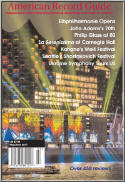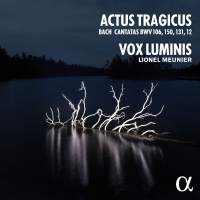Texte paru dans: / Appeared in: |
|
|
Outil de traduction ~ (Très approximatif) |
|
|
Reviewer: Wlliam
J. Gatens The four works on this recording—Gottes Zeit is die Allerbeste Zeit (106), Nach dir, Herr, Verlanget Mich (150), Aus der Tiefen (131), and Weinen, Klagen, Sorgen, Zagen (12)—are among the earliest of JS Bach’s cantatas. The first three most likely date from his years at Mühlhausen (1707-8), and the fourth was written in 1714 at Weimar. Bach’s classic Leipzig cantatas reflect the structural format promoted by poet and theologian Erdmann Neumeister (1671-1756), with alternating recitatives and arias in the manner of an Italian chamber cantata or operatic scene, often opening with a substantial chorus and concluding with a fourpart chorale. The present works, in contrast, owe more to the formal model of the 17th-Century sacred concerto as developed from Schütz to Buxtehude. The Mühlhausen cantatas unfold as a tapestry of short sections rather than extended and developed movements. Where chorale melodies occur, as in 106 and 131, they appear as a strand of the texture, though as pre-existing musical material they must of necessity determine the structure of the music where they occur. They suggest an almost improvisational fluidity as the music so readily reflects the shifting expressive properties of the text; and of course, Bach’s technical mastery, even as a young man, is everywhere in evidence. The small-scale instrumentation gives these works the intimate flavor of chamber music—a quality conveyed by these recorded performances. In Weinen, Klagen from Weimar, Bach comes closer to the Leipzig model with more extensive arias; but even here they are not linked by recitatives, and the one movement so designated could better be described as an accompanied recitative with arioso. Bach must have retained a high regard for this cantata, as many years later he reworked its first chorus as the ‘Crucifixus’ of the B minor Mass. The young singers and players of Vox Luminis give very attractive performances, though perhaps not quite as seasoned or polished as the most celebrated exponents of this repertory. Director Lionel Meunier plays the recorder in 106 and sings in the other three cantatas. One voice per part is listed for 106. The other cantatas are sung by a double quartet. The recorded sound is generally excellent, but there are times when the balance seems to favor the instruments over the voices, and I think that a mistake. Readers with a special interest in this early Bach cantata repertory will find much to admire in these performances. | |
|
|
|
|
Cliquez l'un ou l'autre
bouton pour découvrir bien d'autres critiques de CD |
|




